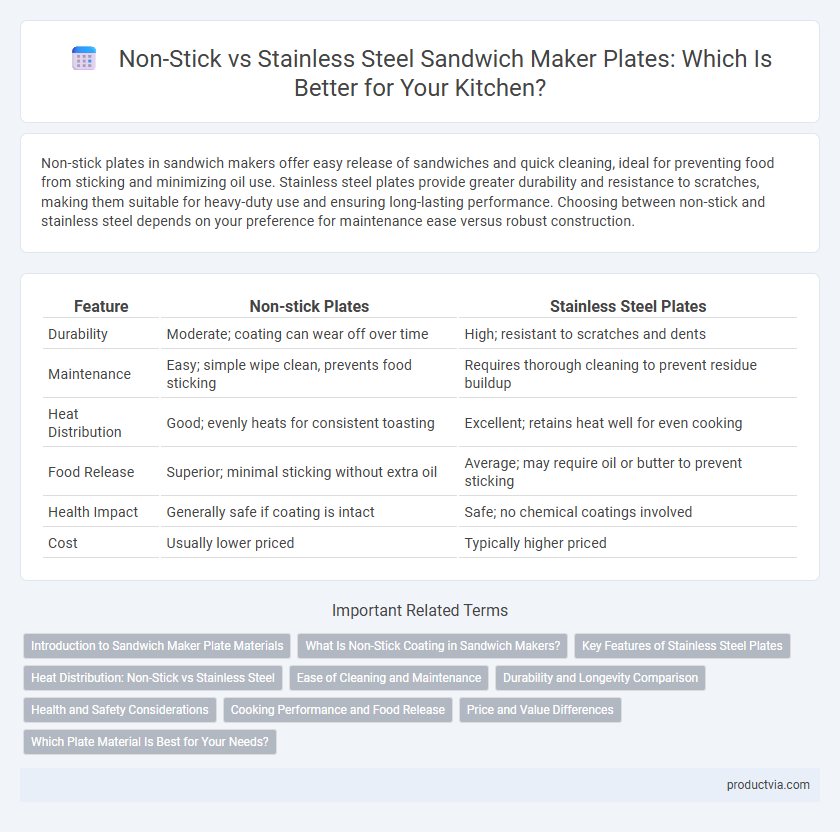Non-stick plates in sandwich makers offer easy release of sandwiches and quick cleaning, ideal for preventing food from sticking and minimizing oil use. Stainless steel plates provide greater durability and resistance to scratches, making them suitable for heavy-duty use and ensuring long-lasting performance. Choosing between non-stick and stainless steel depends on your preference for maintenance ease versus robust construction.
Table of Comparison
| Feature | Non-stick Plates | Stainless Steel Plates |
|---|---|---|
| Durability | Moderate; coating can wear off over time | High; resistant to scratches and dents |
| Maintenance | Easy; simple wipe clean, prevents food sticking | Requires thorough cleaning to prevent residue buildup |
| Heat Distribution | Good; evenly heats for consistent toasting | Excellent; retains heat well for even cooking |
| Food Release | Superior; minimal sticking without extra oil | Average; may require oil or butter to prevent sticking |
| Health Impact | Generally safe if coating is intact | Safe; no chemical coatings involved |
| Cost | Usually lower priced | Typically higher priced |
Introduction to Sandwich Maker Plate Materials
Sandwich maker plates are commonly crafted from either non-stick or stainless steel materials, each offering distinct advantages for cooking performance and maintenance. Non-stick plates feature a coating that prevents food from adhering, ensuring easy release and effortless cleaning, while stainless steel plates provide superior durability and resistance to scratches and wear. Understanding the differences in heat conduction, cleaning process, and longevity between these materials helps consumers select the optimal sandwich maker for their culinary needs.
What Is Non-Stick Coating in Sandwich Makers?
Non-stick coating in sandwich makers is typically made from materials like Teflon or ceramic, designed to prevent food from sticking to the plates during cooking. This coating allows for easier cleaning and requires less oil or butter, promoting healthier sandwich preparation. Unlike stainless steel plates, non-stick surfaces deliver uniform heat distribution while minimizing the risk of burnt residues.
Key Features of Stainless Steel Plates
Stainless steel sandwich maker plates offer exceptional durability and resistance to corrosion, making them ideal for long-term use. Their smooth surface provides even heat distribution for consistent sandwich toasting and easy maintenance without the risk of scratching or peeling. Unlike non-stick coatings, stainless steel plates can withstand metal utensils and abrasive cleaning, enhancing their longevity and hygiene.
Heat Distribution: Non-Stick vs Stainless Steel
Non-stick sandwich maker plates provide even heat distribution with minimal hot spots, ensuring consistent toasting and easy release of sandwiches. Stainless steel plates offer durable heat conduction but may develop uneven heating areas, potentially causing inconsistent cooking results. Choosing non-stick plates enhances cooking performance and maintenance due to their superior heat distribution and non-adhesive surface.
Ease of Cleaning and Maintenance
Non-stick sandwich maker plates offer superior ease of cleaning due to their smooth, coated surfaces that prevent food from sticking, requiring only a gentle wipe with a damp cloth after use. Stainless steel plates, while more durable and resistant to scratches, tend to retain food residue and require scrubbing with specialized brushes or detergents for thorough cleaning. Regular maintenance of non-stick plates preserves their coating integrity, whereas stainless steel plates demand frequent polishing to maintain their shine and prevent staining.
Durability and Longevity Comparison
Non-stick sandwich maker plates offer excellent ease of cleaning and prevent food from sticking but tend to wear out faster due to coating degradation over time. Stainless steel plates provide superior durability and longevity, resisting scratches, dents, and high heat without compromising performance. Investing in stainless steel plates ensures a longer-lasting appliance with consistent cooking results for extended use.
Health and Safety Considerations
Non-stick sandwich maker plates offer easy food release and require less oil, reducing calorie intake and minimizing the risk of harmful chemical ingestion when used properly. Stainless steel plates provide durability and resist scratching, preventing the potential leaching of toxic substances while allowing thorough cleaning to avoid bacterial buildup. Both materials demand regular maintenance to ensure safe cooking conditions and prevent contamination.
Cooking Performance and Food Release
Non-stick sandwich maker plates offer superior cooking performance by ensuring even heat distribution and efficient browning, while providing excellent food release that minimizes sticking and eases cleaning. Stainless steel plates excel in durability and heat retention but may require more oil or butter to prevent sandwich ingredients from adhering, potentially affecting food texture. Choosing between non-stick and stainless steel depends on prioritizing ease of release and maintenance versus long-term plate robustness.
Price and Value Differences
Non-stick sandwich maker plates generally come at a lower price point and offer excellent value for easy cleaning and stick-free cooking, making them ideal for casual use. Stainless steel plates, while typically more expensive, provide superior durability and can withstand higher temperatures, delivering long-term cost efficiency for frequent users. Choosing between non-stick and stainless steel depends on balancing upfront cost against longevity and maintenance preferences.
Which Plate Material Is Best for Your Needs?
Non-stick plates offer quick release and easy cleaning, making them ideal for everyday sandwich makers focused on convenience and low maintenance. Stainless steel plates provide superior durability and heat resistance, perfect for heavy use and those seeking long-lasting performance without coating wear. Choosing between non-stick and stainless steel depends on prioritizing ease of use versus robust durability for your sandwich maker needs.
Non-stick vs Stainless steel for sandwich maker plates Infographic

 productvia.com
productvia.com